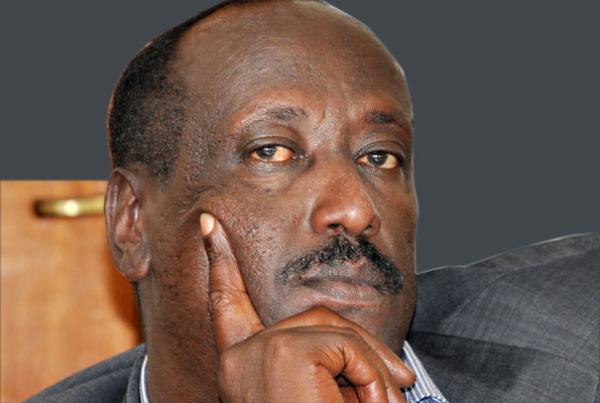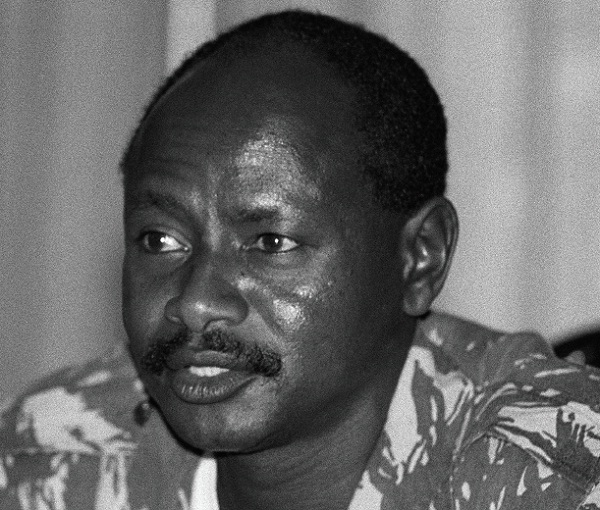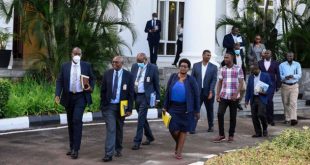
On the 28th of December, 1984, a force from the UNLA in Bukomero attacked us. We repulsed them. I was now happy that our deception was working. Possibly, on the 30th of December, I moved the force to our old site of Kagaari, in Dr. Sebuliba’s farm, where we camped.
We had last camped here on the 10th of February, 1981, following our being dislodged from Kagobe, near Kiboga by the Tanzanians. Around 1400 hours on New Year’s Day, 1985, the good news came through our usual informer ─ the UNLA radio-operators. A military radio message was sent, I think, from Mubeende, that, that morning a powerful enemy force had attacked Kabaamba barracks, overrun it and were still there. The force from Mubeende had made repeated counter-attacks, but had been repulsed. I immediately, called a Master-Parade of our force of 800 and conveyed the good news to the force.
I, however, decided that it was late and decided to start the march to the West, the following day, the 2nd of January, 1985. On the 2nd, we moved out of the Lukoola, climbed the Ssingo hills on both sides of Hoima Road and ended up in Kyamusisi. Did we cover the distance in one day? I do not clearly, remember. However, on Bulaga hill, I fainted but Dr. Besigye gave me re-hydration salts and I resumed the march. Earlier on, in Karagwe, Tanzania, I had learnt the strain on the body when climbing hills. It is wise to have rests after short bounds; also use a support stick (empiimbo). On the Bulaga hill, I had not observed those rules.
Eventually, we established radio link with Saleh. After successfully attacking Kabaamba, he had marched West, towards Kyaaka, crossed the Mubende-Fort Portal Road at Kyegyegwa, fought battles with UNLA at Hapuuyo and continued marching and fighting. We now decided to link up in the Bugangaizi area, instead of using the Lake Wamala route that Saleh had used on the way out. By difficult marches, by day and by night, we went through Bukuya, Butoloogo, crossed Hoima-Kakumiro road at Nkoondo and camped at Kasaambya Sub-County Headquarters on the afternoon of the 8th of January, 1985. There, through the usual radio communication, we agreed with Saleh to link up at Bireembo, only 8 miles from Kasaambya Sub-county headquarters. The link was effected on the 9th of January, 1985. The Kabaamba operation/battle had been almost as successful as the Masindi one. 650 rifles, mortars, machine-guns, ammunition, etc., had been captured. It was another historic victory for the NRA.
Saleh’s force, having marched by night after night, starting with the Christmas day of 1984, had arrived at Kabaamba, having walked along the railway line, on the morning of the first day of the New Year, 1985. Seeing the huge extended-line of the NRA fighters, the UNLA soldiers had fled.
The battle was now left to one soldier, who entered the underground armoury of Kabaamba and tried to imitate the heroic action of the Tanzania NCO that had blocked us with machine-gun fire on the 6th of February, 1981.
Since I had been in all those efforts, I now designed a medicine for that eventuality.
Out of the 100 land-mines we had got from Gaddaffi in 1981, only 4 were now remaining. The 96 landmines had been used to wreak havoc on the UNLA who stupidly insisted on using vehicles that were, really, moving coffins. Since the External Committee had failed to get additional guns out of the chaotic Libyans, we were now remaining with only 4 pieces. I decided to use one of them for this strategic task of liberating the guns Fronasa had handed in at Kabaamba in the 1979/80 unification of the armed groups. Anticipating the repetition of the Tanzanian Corporal’s actions, I decided to weaponize one of the cattle-keepers techniques. This is the technology of ekiteeko. Ekiteeko is a fibre mesh made out of the tough Kaamba (Sisal fibres). The sisal fibres (Kaamba) and ropes (emigoye, ebitsibo) are very tough. There is even a riddle (ekiito, ekishaakuzo) which goes like this: “Shaku shaku!!” The other ones (the audience) answer: “Shambagira”.
I cannot translate these because, even I, do not know their meaning. It must be long lost. What we know is that this is a standard form of challenging the wits of one another with riddles (ebikokyo in Luganda) that have hidden messages and meanings. The one praising the ekiteeko goes like this, again: “Shaaku, shaaku!!” The answer is “Shambagira”. Then the riddle (ekiito ekikokyo) goes like this: “Nyabukono bukye, nyankubito egumire!!” ─ “the small armed item but with lot of strength!!” It is the ekiteeko (the sisal mesh) that holds milk-pots, ebishaabo (milk gourds ─ the big ghee ─ churning ones), ebirere (the smaller gourds for yorghurt – amakamo or skimmed milk – amachuunda). It is this “small-armed” (nyabukono bukye) but with alot of strength (nyankubito egumire), that I turned to so as to solve the problems of a possible machine-gunner in the under-ground armoury of Kabaamba. Get one of the Gaddaffi land-mines, use a car battery to create an electric current, put an electric detonator in the landmine, put the so armed land-mine in the ekiteeko, from the top of the armoury lower the mine to the mouth of the armoury (the opening) and electrically detonate it.
It will stun the underground warrior and our group will assault. Apparently, my military field engineering (using explosives), worked even better. The poor fellow died by concussion.
I had not anticipated that extreme result. Therefore, the under-ground armoury was overcome in that way and the weapons were safely got out. The UNLA counter-offensive, now led by Ogole and Odwar, tried to make Saleh drop the guns by incessant attacks: Hapuuyo and Kabaamba itself. The inconvenience for the Saleh group was that they were heavy – laden, not with sins as the Church hymn goes, but with the means of liberation because they were the fighters to repulse Ogole and Odwar and at the same time carry the heavy loads of weapons. Their double-burden: fight and carry. The urgent tasks now were to relieve the fighters of the burden of carrying and to expand the fighting force by arming the unarmed (the commandoes). Hence, the link up at Bireembo. When we joined with the Salehs below Bireembo Primary School, I did not like their camp-site ─ in the valley – on the banks of Nkusi River.
The greatest Commander of the NRA/UPDF (Afande Salim Saleh) giving the troops the final briefing in December 1985 before the fall of Kampala. The NRA was an army of heroes that captured Kampala (after 5 years of a gruelling insurgency). pic.twitter.com/AIYsfo1oEE
— Muhoozi Kainerugaba (@mkainerugaba) December 21, 2019
The Bunyoro vegetation at that time was very thick with narrow paths that were like tunnels under the massed and intertwined vegetation. With people carrying heavy loads, that was a disaster waiting to happen. I ordered that we move out of the valley and camp at Bireembo Primary School where the road was wide and the Bulungi-bwansi roads were also wide and open enough. The issue here was not concealment, but ease of mobility for the heavy-laden vast column.
On the 10th of January, the force moved out of the valley and started camping at the school. At around 10:00 hours, however, Ogole and Odwar launched a heavy artillery bombardment and a ground-attack. We repulsed the attacks but the artillery killed 3 of our fighters and injured another two who died later. The battle had gone on for the whole day. Some of the shells hit near my trench. One of my close body-guards, was injured.
In the night, however, we successfully pulled out and by morning, we were quite far, heading for Nkooko and Ntwetwe. We walked the whole day of the 11th, went through Nkooko in the night and entered Ntwetwe where one of our supporters ─ Kigoongo─had alot of maize grain – belonging to their Cooperative Society. I paid him for the whole maize, but told him to report to the UNLA, when we left, that the guerrillas had locked him up and grabbed his maize. The deception worked. Our supporters got their payment, we got the grain and the UNLA did not penalize our supporters because they believed the story.
The UNLA came on our track towards Nkooko and were aimlessly shelling the forests of the area. At night, I think, on the 12th of January, we moved out of Ntwetwe, crossed some swamps, marched until daylight, continued marching, crossed a River called Mpongo and laid a big ambush on Bukwiiri ─ Ntwetwe Road, where we destroyed another UNLA convoy capturing more guns. Ogole came with a helicopter ─ a 206 Agusta-Bell ─ where-upon we saluted him with gun-fire. His helicopter fled. Eventually, we crossed Hoima Road at Rwamagaari and re-entered the Lukoola. Ogole and Odwar had lost the battles and the operation. We, eventually, camped at Nyambiindo and re-organized the force creating the battalions that pushed the UPC regime to its evening hours. The battalions, now reinforced with more rifles were:
1st BN ─ Pecos and Mugisha;
3rd BN ─ Lumumba;
5th BN ─ Kashaka and Kashillingi;
7th BN ─ Kyaligoonza and Muhangyi;
9th BN ─ Kihaanda;
11th BN ─ Chefe Ali.
I think, by this time, each of these battalions had 4 companies, each coy with 75 rifles. Therefore, each battalion had 300 rifles. The 6 of them, therefore, had 1,800 rifles. These did not include the rifles of the zonal units of: Black Bomber (Abdul Naser), Mondlane, Luttamaguzi, Kabaleega, Ngoma, Nkrumah and Kiwanguzi. By now, there were like two companies of the High Command unit ─ the bodyguards of CHC ─ the Chairman of the High Command. Ogole, again, flew over us and this time, we almost brought him down. After re-organizing, we marched the whole length of the Lukoola, passed Kansiri, climbed the Luanda hills, above present day Ssingo barracks and entered the Kikandwa forest on the 21st of January, 1985.
When we camped, I switched on my small radio and heard a BBC announcement saying that our Chairman, Professor Lule, had died in London. That is why I remember that date very well.
While in Kikandwa forest, we were, again, attacked by Erica Odwar, but repulsed him. After like a day, we moved out of the forest at night with our luggage and started walking along the Kirema-Kabele Bulungi-bwansi Road. The UNLA at Namirembe really shelled us with Katsyushas and the 120mm mortar. The Katsyushas, obstructed by the Namirembe hill and with the poorly trained UNLA, given their slanting elevation, were firing very far from us, hitting the Semuto area. The more dangerous were the 120mm mortar because they were firing parabolically, sometimes even almost 800. They can, therefore, loop shells over ridges and they fall right behind the ridge which is where we were marching along. However, we maintained a steady pace until we got out of range of the mortars, crossed Kabele junction and linked up with the base camp at Kikoko, beyond Migingye.

Therefore, the years 1984/5, exactly 100 years after the shameful 1884/5 that saw the Congress of Berlin where the Europeans shared out a prostrate Africa, were years of victory for the NRA. In that year of shame, the NRA, supported by the people, wrote a glorious story of heroism, sacrifice and skill. Victory for the forces of Patriotism and Pan-Africanism in Uganda was drawing near. Indeed, in June that year, 1985, two other battles took place ─ Rubona and Kembogo. Especially, the latter one, was decisive. The massed UNLA battalions were defeated by the Mobile Brigade, again under Saleh; that marked the end of the Obote regime. The defeated UNLA came to Kampala and overthrew Obote.
The Galamba-Bireembo Trek is, therefore, not the only important trek. There are others which should be marked at different times. These are: the Kanyaara-Masindi operation; the other portions of the Kabaamba operation ─ from Kyamusisi to Kabaamba –Kyaaka-Hapuuyo-Bireembo; the Hoima Operation; the opening of the 2nd Front; the sweep to the West, resulting in the envelopment of the Masaka barracks and the protracted Katoonga battle (September, 1985 to December, 1985); and others that should be identified. The Galamba-Bireembo portion, nevertheless, has some interesting elements, especially the elements of: endurance, maneuver, concealment, even when there was a leakage; and successful deception to counter-the leakage of information and a lower tempo of momentum then, previously estimated; and achieving surprise in spite of the leakage.
 The Independent Uganda: You get the Truth we Pay the Price
The Independent Uganda: You get the Truth we Pay the Price



Thank you for sharing these insights. Reading from His Excellency The President of Uganda, Dr. Y.K. Museveni giving his narratives is informative and characterizes peace building mechanisms in the Uganda of the 1980’s. My questions though are around the cycles, most especially the operations, the President lays out. I am not refuting them but I am afraid what the President leaves out prompted to ask more questions than answers. The president writes about massive recruitment from Western Uganda. But, doesn’t he need to say something about the role of the Central region that set the theater out of which the war rolled out to cover Uganda? After all this very trek has significant meaning to many in the regions he is trekking through. Where can the use of radio, literature and pamphlets come in? My own father was one of the people who distributed the pamphlets! Thirdly, where do other fighters other than the Resistance Forces come in? Fourthly, where do we place the citizens who gave up cows, goats and money to sponsor the war? How would the president put these contributory phases in the narrative of liberation war? Thanks and hope to hear from you.
I hope his young trekkers will be able to take the heat after 2021. The president is inciting rebellion after his 2021 general Election. My humble advice to those young trekkers is not to allow to be misled into illegal and treasonous activities because some of us will get involved to counter it. Okay!, try and we see.